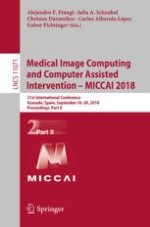2018 | OriginalPaper | Buchkapitel
Small Lesion Classification in Dynamic Contrast Enhancement MRI for Breast Cancer Early Detection
verfasst von : Hao Zheng, Yun Gu, Yulei Qin, Xiaolin Huang, Jie Yang, Guang-Zhong Yang
Erschienen in: Medical Image Computing and Computer Assisted Intervention – MICCAI 2018
Aktivieren Sie unsere intelligente Suche, um passende Fachinhalte oder Patente zu finden.
Wählen Sie Textabschnitte aus um mit Künstlicher Intelligenz passenden Patente zu finden. powered by
Markieren Sie Textabschnitte, um KI-gestützt weitere passende Inhalte zu finden. powered by
